Dev, Devis, Yaksh &Yaksinis
By Mr. Pramoda Chitrabhanu
There is a large pantheon o lesser gods, goddesses and other divinities that the Jains worship and so all the twenty four Tirthankaras have deities as their devotees. They are called the devas, devis, yakshas or yakshinis.
The presence of these divine forces emanate positive vibrations of harmlessness, confidence and protection in the temple and the surroundings.
The statues of deities are installed in cells on the sides of the main temple. Sometimes they are also placed in the corners near the entrances. However, one must remember that they cannot be esteemed higher than the Jinas. The major objects of worship, however are the Tirthankaras and other liberated souls who are called Lords of the gods. The deities are, in fact, the devotees of Jinas and to bow to them as one would to a Jina, is being disrespectful. One may respect them and believe in their power and energy, but for spiritual advancement, surrendering to the Jinas is the true obeisance.
In this section few of the popular deities are described. As a protocol one performs puja of the Jina and them pays respect to these deities.
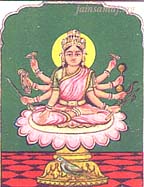 |
Chakreshwari Devi
She is the dedicated attendant deity of Lord Adinatha (Rishabhdev). She is also called by another name i.e. Apratichakra. The color of this goddess is golden. Her vehicle is the eagle. She has eight arms. In her four right hands she holds four diffecent obiects - the bleesing mudra, arrow for target, rope for hope and wheel of light. In her four left hands she holds the rein, the bow, the protective weapon of Indra and the wheel.
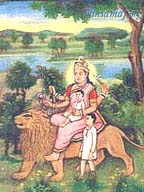 |
Ambika Devi
She is the dedicated deity of Lord Neminath, the 22nd Tirthankara. She is also called Ambai, Amba and Amra Kushmanadini. Her color is golden and the lion is her vehicle. She has four arms. In her tow right hands she carries a mango and in the other a branch of a mango tree. In her one left hand she carries a rein and in the other she has two sons.
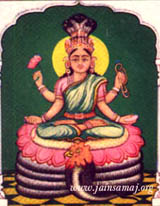 |
Padmavati Devi
She is the dedicated deity of Lord Parshvanath, the 23rd Tirthankara. Her color is golden and her vehicle is a snake with a cock's head. She has four arms and her two right hands hold a lotus and a rosary. The two left hands hold a fruit and a rein.
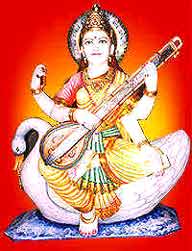 |
Saraswati Devi
Saraswati, the goddess of knowledge, is considered to be the source of learning. This divine energy is the source of spiritual light, remover of ignorance and promoter of knowledge. She is respected and adored by all faiths, worldly persons and saints. She has four arms, one holding a book, the other a rosary and two hands holding a musical instrument. Her seat is a lotus and the peacock is her vehicle representing equanimity in prosperity. In some places it is mentioned that the swan is her vehicle.
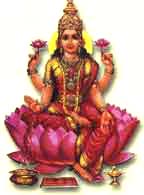 |
Lakshme Devi
Goddess Lakshmi represents wealth. People worship her as the goddess of wealth, power, money etc. In the upper two hands, she is holding a lotus with and elephant. In the lower right hand a pot and in the lower left hand abundant wealth is flowing.
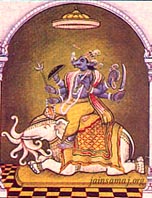 |
Manibhadra Dev
Shri Manibhadra is originally a yaksha, worshiped by Indian masses from very old times and his introduction in Jain worship is only a later adaptation. It is an image of a six armed yaksha with an elephant as his vehicle. Vehicle represents the different ways of traveling along the spiritual path leading to illumination and thereafter salvation.
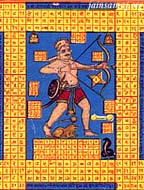 |
Ghantakarna Veer
This deity is worshipped for protection and driving away the evil influence created by lower types of negative energy. His arrow indicates penetration of evil forces. The bow gives forceful momentum to the arrow. His symbol is the bell which resounds to create auspicious sounds in the atmosphere. Sometimes people who are not aware of the fact call him by the name Ghantakarna Mahavira which creates confusion between Lord Vardhaman Mahavira and Ghantakarna Veer.
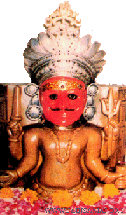 |
Nakoda Bhairava
This is the tutelary deity of Bhairava. This deity is usually found near the entrance of the temple. People from far and near, visit the shrine and make offerings to the deity on fulfillment of their material desires. It is the positive force around the temple.
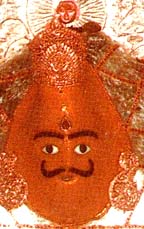 |
Bhomiyaji
This deity is in the shape of a mountain. It is the natural positive energy of the mountain Sametshikharji. This energy inspires and guides the devotee and the traveler in his onward journey to the mountain.
-----------------------------------------------------
Article Courtesy : Mr. Pramoda Chitrabhanu
Jain Meditation International, PO Box No. 230244 Ansonia
New York NY 10023-0244, Tele & Fax : 212/362 6483, E-Mail : jainmamata@aol.com
-----------------------------------------------------
Mail to : Ahimsa Foundation
www.jainsamaj.org
R211102